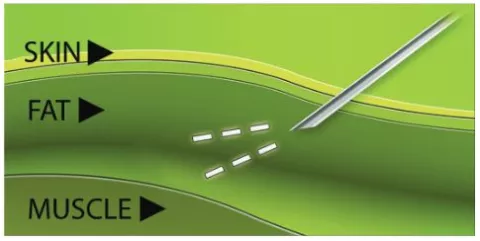Testosterone pellets (Testopel) are one option for patients taking testosterone. Pellets are inserted under the skin in the buttock area, and slowly release testosterone into your body. The pellets dissolve over the course of 2-6 months and do not need to be removed once they have dissolved. Pellets are most commonly replaced every 3 months to maintain even testosterone levels, though some people may require more frequent placements, and others can go longer. The frequency of placement as well as the number of pellets placed is guided by testosterone levels in your blood. Your provider will order blood tests to be done at specific times after each placement of pellets. The levels of testosterone in your body will be adjusted based on your goals and how your body responds to the treatment. Testopel allows you to avoid weekly injections, daily gels or patches, or twice/daily pills.
Pellets are inserted into the below area of the body, on the upper outer buttock. The area is cleaned and sterilized and then covered with a drape while you lie on your side or stomach. A numbing injection is given first to the overlying skin, and then deeper into the fat layer between your skin and muscle. This is where the pellets will be placed. The numbing shot can sting, however after this initial discomfort, the procedure does not hurt, though you may feel some pressure in the area. Notify your provider immediately during the procedure if you feel pain.
After you are numb, a small incision (about 3mm or 1/2 inch) will be made, and then a tube about the size of a coffee stirrer will be inserted through the incision and into the fat that lies between the skin and muscle. The pellets will be inserted through the tube into this fat layer by placing the pellets in the tube, and then using a thin rod to push them through the tube into place. Once finished, the tube will be removed and a small piece of tape will be used to close the incision, which will then be covered with gauze and a clear large piece of tape to seal off the entire area.


After the procedure, you can apply an ice pack to the area for 20-30 minutes every 1 to 2 hours for the next 12-24 hours to keep the swelling down. Watch for any signs of infection such as swelling, redness, warmth, pain, or fever. If you develop any of these symptoms, notify your provider or go to the emergency department for evaluation. If you feel the pellets are getting dislodged, or if they come out of your body, notify your provider. Infection, dislodged pellets, or local damage to tissues are extremely rare.
The dressing over the wound can be removed in 48 hours, after which you can gently cleanse the area with soap and water. Do not use peroxide or iodine, and antibiotic ointment is not necessary. Avoid swimming, hot tubs, or full water immersion until the incision has fully healed closed, which typically will take 48-96 hours.
